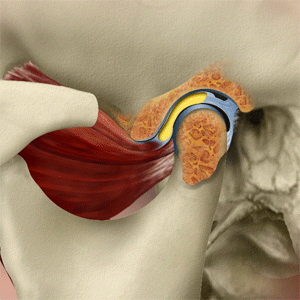
Rich Hirschinger, DDS, MBA
Diplomate American Board of Orofacial Pain
9615 Brighton Way, Suite 323
Beverly Hills, CA 90210
888.981.8981
Diplomate American Board of Orofacial Pain
9615 Brighton Way, Suite 323
Beverly Hills, CA 90210
888.981.8981
 What is TMJD?
What is TMJD?
Temporomandibular joint disorder, also known as TMJ, TMD, or TMJD, is a general term covering any disorder causing inflammation of the temporomandibular joint, which connects the skull to the mandible. There are a number of conditions that can cause pain in the jaw joint and the muscles involved in the closing and opening of the jaw. Disorders affecting the temporomandibular joint can affect a person's ability to eat, speak, swallow, chew, and breathe.The set of TMJ disorders are commonly divided into three general categories, though multiple conditions may be present at once.
Inflammatory joint disease: Arthritis is a disease that causes inflammation of the joints. A number of forms of arthritis including rheumatoid arthritis, osteoarthritis, traumatic arthritis and infectious arthritis may have an effect on the jaw joint. Synovitis is another condition that can bring about TMJ pain where the synovial membrane that lines the joint and lubricates it becomes inflamed.
Myofascial pain: The jaw joint and muscles around it can be affected by myofascial pain. This is a disorder where trigger points and muscle tension, commonly in the neck, back and shoulder areas, cause pain in a localized area and referred pain from another region of the body.
Internal derangement of the temporomandibular joint: Between the mandible and the skull is a disc that acts as a cushion. Displacement or deterioration of the disc can cause pain and inflammation of the joint.
A person suffering from TMJD may experience:
- Clicking or popping noise in the jaw
- Being unable to open the mouth comfortably
- Locking of the jaw when trying to open the mouth
- Neck pain, shoulder pain, back pain or headaches
- An irregular bite
- Swelling of the face around the jaw joint
- Ringing in the ears or decreased hearing
- Dizziness and vision problems
TMJ disorders are still relatively unexamined area of medicine, and as such, diagnosis and treatment of these conditions can be difficult. There is no standard accepted test for diagnosing TMJD and both the American Dental Association and the American Medical Association have not established the TMJ area as a specialty due to insufficient scientific research.
Still, what is known about TMJD has been used to effectively treat or manage the symptoms of the condition, and ongoing research continues to evolve treatments and broader understanding of the causes and risk factors for TMJD.
Occasional discomfort or pain of the jaw joint or facial muscles is not uncommon and can occur for any number of reasons. Often TMJ pain goes away within days or weeks, but if the problem persists for a month or more, a doctor should be consulted.





